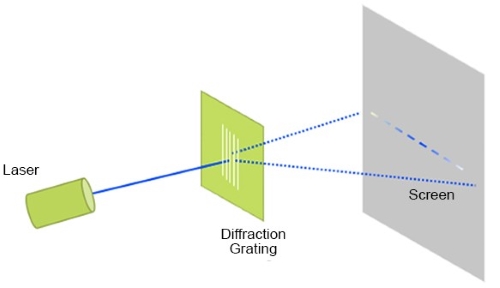
A diffraction grating is an optical component that is used to disperse light into its constituent colors or wavelengths. It consists of a large number of equally spaced, parallel slits or rulings that are closely packed together. When light passes through a diffraction grating, it undergoes a phenomenon called diffraction, which results in the separation of light into its various spectral components. In this article, we will explore the diffraction grating formula in detail, discussing its components, applications, and the physics behind it.
Introduction to Diffraction Grating
A diffraction grating is a powerful tool in optics and spectroscopy. It is designed to separate incoming light into its individual wavelengths or colors, which is essential for applications such as spectroscopy, where the analysis of light's spectral composition is crucial. Diffraction gratings are commonly used in devices like spectrometers, monochromators, and other optical instruments for this purpose.
How Diffraction Gratings Formula Work?
Diffraction gratings work based on the principle of diffraction, which is the bending of light as it encounters an obstacle or aperture. When light passes through the narrow slits or rulings of a diffraction grating, it undergoes diffraction, causing the light waves to interfere with each other constructively and destructively. This interference pattern results in the dispersion of light into its various wavelengths.Also Check - Heat Gain Formula
The key factors that determine the characteristics of the diffraction pattern produced by a grating are: - Wavelength of light (λ): The wavelength of the incident light is a crucial factor. Different wavelengths will be separated by different angles, allowing the grating to act as a spectral disperser. - Spacing of the grating (d): The distance between adjacent rulings or slits on the grating is known as the grating spacing. It plays a significant role in determining the angles at which different wavelengths are diffracted. - Order of diffraction (m): Diffraction can occur at different orders, labeled as m. The zeroth order (m = 0) corresponds to undiffracted light, while positive and negative orders represent different orders of diffraction. Higher orders result in greater angular separation between wavelengths.Also Check - Fluid Dynamics Formula
Formula Of Diffraction Grating
- The Diffraction Grating Equation:
Also Check - Induced Voltage Formula
4. Applications of Diffraction Grating
Diffraction gratings have a wide range of applications across various fields. Some of the notable applications include: - Spectroscopy : Diffraction gratings are fundamental components in spectrometers used for chemical analysis, astronomy, and materials characterization. They enable the separation and measurement of the spectral lines emitted or absorbed by different substances. - Wavelength Selection: In lasers, diffraction gratings formula are used to select specific wavelengths, allowing for the tuning of laser output. This is crucial in applications like telecommunications and medical devices. - Color Separation: In optics and photography, diffraction gratings are used to separate colors, as seen in some camera lenses and optical filters. - Astronomy: Gratings are used in astronomical spectrographs to analyze the light emitted or absorbed by celestial objects, helping scientists determine their chemical composition, temperature, and other properties. - Light Analysis: In physics experiments, gratings are used to study the behavior of light and validate theories related to wave optics.Also Check - Hubbles Law Formula
5. Understanding the Diffraction Grating Equation
Let's dive deeper into the components of the diffraction grating formula equation and understand how it works: Order of Diffraction (m): The order of diffraction (m) is an integer value that indicates which diffraction order you are interested in. The zeroth order (m = 0) corresponds to the undiffracted, central beam. Positive integers (m = 1, 2, 3, ...) represent higher orders on one side of the central beam, while negative integers (m = -1, -2, -3, ...) represent orders on the other side. Higher diffraction orders are farther from the central beam and result in greater angular separation between wavelengths. For example, the first-order (m = 1) diffraction angle will be larger than the second-order (m = 2) angle for the same wavelength. Wavelength of Light (λ): The wavelength of light (λ) is the distance between successive peaks (or troughs) of a light wave. It is typically measured in nanometers (nm) or angstroms (Å). Different colors of light have different wavelengths. For example, red light has a longer wavelength than blue light. Grating Spacing (d): The grating spacing (d) is the distance between adjacent rulings or slits on the diffraction grating. It is a crucial parameter that determines the angular dispersion of light. A smaller grating spacing will result in a larger angular separation between wavelengths. Angle of Diffraction (θ): The angle of diffraction (θ) is the angle between the incident light direction and the direction of the diffracted light. It is measured in radians. The diffraction angle depends on both the wavelength of light and the order of diffraction, as given by the diffraction grating equation.6. Practical Considerations:
In practice, when using a diffraction grating formula, you typically know the wavelength of the incident light (λ) and the order of diffraction (m) you are interested in. You can then use the diffraction grating equation to calculate the angle of diffraction (θ) and determine where the diffracted light will be observed.Here are some practical considerations:
- Calibration: To accurately measure wavelengths, you need to calibrate your diffraction grating formula setup. This often involves using known spectral lines or sources of known wavelength to establish a relationship between the angle of diffraction and wavelength. - Higher Orders: Higher-order diffractions can be used to disperse light over a wider range of angles, but they are also farther from the central beam and can be weaker in intensity. - Grating Efficiency: Not all incident light is diffracted by the grating. Some of it is lost through absorption or reflection. Grating efficiency is a measure of how effectively a grating disperses light and can vary with the design and manufacturing of the grating. - Blazing: Some gratings are designed to maximize efficiency at a particular wavelength or order of diffraction. This is known as blazing, and it involves optimizing the groove profile of the grating.Diffraction Grating Formula FAQs
What is the purpose of a diffraction grating in spectroscopy?
How does the diffraction grating equation help in wavelength determination?
Are there different types of diffraction gratings, and how do they differ?
What is spectral resolution, and why is it important in spectroscopy?










